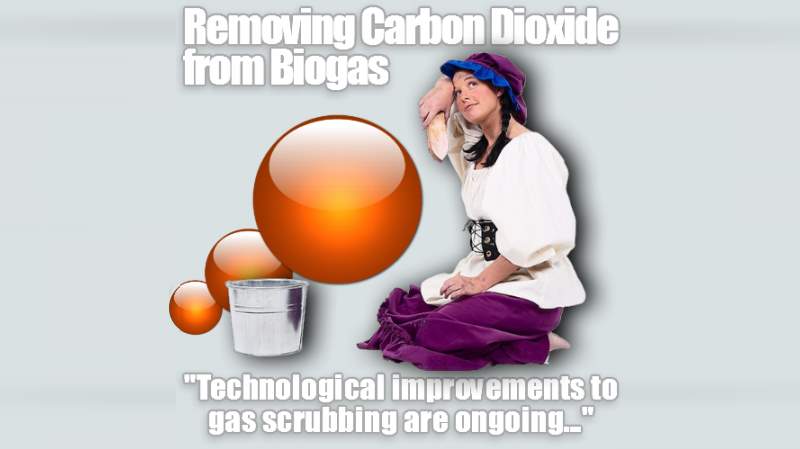2014 will probably be seen in years to come as a turning point in the development of the anaerobic digestion and biogas energy industry in the U.S.: The year when their industry came of age and finally began to take-off in terms of business.
Last year the USDA, with the EPA and DOE at their side, published a Biogas Opportunities Roadmap report. It described the steps that these three Federal Agencies will take to increase the uptake of the anaerobic digestion with the development of many more biogas plants in the United States, on a scale hardly even imagined previously.
Their "Roadmap" outlines the ways in which those that want to promote waste fed anaerobic digestion projects will be able to overcome the current regulatory restrictions which have been holding back the development of a healthy (energy from waste) biogas industry in the U.S.
There is no doubt that this will end up creating new jobs, and injecting cash into the nations economy. At the same time these agencies recognise, that an important part of the Roadmap is in its aims to educate the public on the benefits which will flow from biogas development. Within these benefits is of course the ability of these biogas plants to reduce Greenhouse Gas emissions, and in this and in other ways lead to improvement in the nation's environmental quality.
Within the Roadmap there are more than 10,000 farms where it is estimated one of these new alternative energy producing waste processing plants should be built in just a few short years, so the young biogas industry will have plenty to be doing. This news has been welcomed by the American Biogas Association, which is the main industry trade body.
For years, third world ranchers have been using methane from manure to run electrical generators down on the farm. This low pollutant emitting biogas is not only a good local fuel in countries with little or no infrastructure, now even countries like the U.S. will be reaping energy from what is otherwise a very smelly resource.
About 80 percent of the estimated only 160 biogas energy projects in the U.S. are currently installed on dairy farms, which then combust the gas to generate electricity. The combined installed capacity of all dairy farm projects is now nearly 60 MW, and should now rise rapidly.
Until now the value of biogas was not properly understood. Because of that there has been an absence of training and regulation standards. Biogas industry data is under-developed and it has been difficult to secure finance, but in 2015 that should all start to change.
In huge tanks, bacteria will turn waste into methane gas, which is burned in turbines or engines that generate electric power. Each large biogas plant can generate as much as a wind turbine, but this energy is far more valauble as it is generated continuously and is not weather dependent. After methanization, the "digestate" produced is further composted and turned into fertilizer that is used by farms in the region.
Looking back at the last 12 months we wanted to share another biogas development which was one of our favorite moments.
In a recent issue of Biomass Magazine, it was explained that there has been staggering growth in the use of cellulosis renewable information number (RIN) market. To you and me this means that existing alternative energy plants are making much more of it, from compressed natural gas (CNG) to liquified natural gas (LNG). In fact, this renewable energy output surged from 3.5 million in August 2014 to 7.5 million in September 2014, presumably due to new plants coming on-stream.
Also, in 2014, municipalities and others who have long been looking for ways to make the best possible use of landfill gas (LFG) created by anaerobic processes at their landfills, will have been further encouraged to go ahead with landfill gas collection schemes. In 2015 and beyond, many more of these should now be equipped with biogas upgrading equipment, and be used to fuel waste collection fleets, or simply sell the compressed biomethane as CNG.



Another feature in 2014, has been the number of bodies such as universities and computer data-centre operators that have "gone green", and are generating their own electricity from organic waste. Many have installed their own biogas plants, and a number of those are using fuel cells. These fuel cells convert biogas to electricity through an electrochemical process that also reduces nitrogen oxide, sulfur dioxide and particulate matter emissions, usually by more than 70%.
The California Energy Commission was also in the news and is promoting the production of biomethane through regulatory measures. So, California is also keen to see increased uptake of biogas and is seeking ways to capitalize on the emerging high energy feedstocks available in the state. These include wastewater, municipal solid waste and industrial food waste. 2014 has seen them exploring how to encourage utility businesses to install biogas plants, and get the potential consumers of this new alternative energy to use it. This has produced much needed publicity on the market prospects for biomethane, not least in the natural gas powered vehicle market.
In the 1985 blockbuster “Back to the Future” there was a scene when a banana peel was needed to fuel a Delorean.
Not much happened to bring such a prediction into reality in the US until around 2012 when several major project developments were successfully brought on-stream, across the United States. The first food waste digesters were also coming online at that time, and since then they have shown their worth.
Move on to 2014, and finally all the "technology talk" of previous years seems to be being brought forward to real action on the ground. Throughout 2014, federal, state, and local market involvements have been propelling developments forward in anaerobic digestion and biogas plant implementation.
We hope you enjoyed this article, and wish all our readers a very HAPPY NEW YEAR! Don't forget that we do have a comments section below this blog! Did we get our opinion of US events in 2014 right? Your feedback is important to us.
Last year the USDA, with the EPA and DOE at their side, published a Biogas Opportunities Roadmap report. It described the steps that these three Federal Agencies will take to increase the uptake of the anaerobic digestion with the development of many more biogas plants in the United States, on a scale hardly even imagined previously.
 |
| Will 2014 be seen as the year when this "banana power" prediction finally became accepted in the mind of US businesses? |
There is no doubt that this will end up creating new jobs, and injecting cash into the nations economy. At the same time these agencies recognise, that an important part of the Roadmap is in its aims to educate the public on the benefits which will flow from biogas development. Within these benefits is of course the ability of these biogas plants to reduce Greenhouse Gas emissions, and in this and in other ways lead to improvement in the nation's environmental quality.
Within the Roadmap there are more than 10,000 farms where it is estimated one of these new alternative energy producing waste processing plants should be built in just a few short years, so the young biogas industry will have plenty to be doing. This news has been welcomed by the American Biogas Association, which is the main industry trade body.
For years, third world ranchers have been using methane from manure to run electrical generators down on the farm. This low pollutant emitting biogas is not only a good local fuel in countries with little or no infrastructure, now even countries like the U.S. will be reaping energy from what is otherwise a very smelly resource.
About 80 percent of the estimated only 160 biogas energy projects in the U.S. are currently installed on dairy farms, which then combust the gas to generate electricity. The combined installed capacity of all dairy farm projects is now nearly 60 MW, and should now rise rapidly.
Until now the value of biogas was not properly understood. Because of that there has been an absence of training and regulation standards. Biogas industry data is under-developed and it has been difficult to secure finance, but in 2015 that should all start to change.
In huge tanks, bacteria will turn waste into methane gas, which is burned in turbines or engines that generate electric power. Each large biogas plant can generate as much as a wind turbine, but this energy is far more valauble as it is generated continuously and is not weather dependent. After methanization, the "digestate" produced is further composted and turned into fertilizer that is used by farms in the region.
Looking back at the last 12 months we wanted to share another biogas development which was one of our favorite moments.
In a recent issue of Biomass Magazine, it was explained that there has been staggering growth in the use of cellulosis renewable information number (RIN) market. To you and me this means that existing alternative energy plants are making much more of it, from compressed natural gas (CNG) to liquified natural gas (LNG). In fact, this renewable energy output surged from 3.5 million in August 2014 to 7.5 million in September 2014, presumably due to new plants coming on-stream.
Also, in 2014, municipalities and others who have long been looking for ways to make the best possible use of landfill gas (LFG) created by anaerobic processes at their landfills, will have been further encouraged to go ahead with landfill gas collection schemes. In 2015 and beyond, many more of these should now be equipped with biogas upgrading equipment, and be used to fuel waste collection fleets, or simply sell the compressed biomethane as CNG.
Another feature in 2014, has been the number of bodies such as universities and computer data-centre operators that have "gone green", and are generating their own electricity from organic waste. Many have installed their own biogas plants, and a number of those are using fuel cells. These fuel cells convert biogas to electricity through an electrochemical process that also reduces nitrogen oxide, sulfur dioxide and particulate matter emissions, usually by more than 70%.
The California Energy Commission was also in the news and is promoting the production of biomethane through regulatory measures. So, California is also keen to see increased uptake of biogas and is seeking ways to capitalize on the emerging high energy feedstocks available in the state. These include wastewater, municipal solid waste and industrial food waste. 2014 has seen them exploring how to encourage utility businesses to install biogas plants, and get the potential consumers of this new alternative energy to use it. This has produced much needed publicity on the market prospects for biomethane, not least in the natural gas powered vehicle market.
In the 1985 blockbuster “Back to the Future” there was a scene when a banana peel was needed to fuel a Delorean.
Not much happened to bring such a prediction into reality in the US until around 2012 when several major project developments were successfully brought on-stream, across the United States. The first food waste digesters were also coming online at that time, and since then they have shown their worth.
Move on to 2014, and finally all the "technology talk" of previous years seems to be being brought forward to real action on the ground. Throughout 2014, federal, state, and local market involvements have been propelling developments forward in anaerobic digestion and biogas plant implementation.
We hope you enjoyed this article, and wish all our readers a very HAPPY NEW YEAR! Don't forget that we do have a comments section below this blog! Did we get our opinion of US events in 2014 right? Your feedback is important to us.












